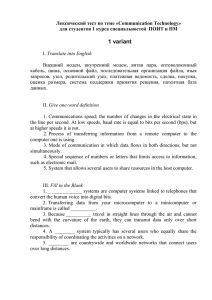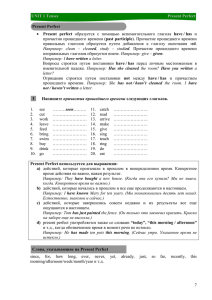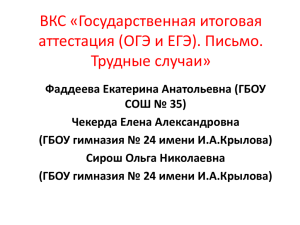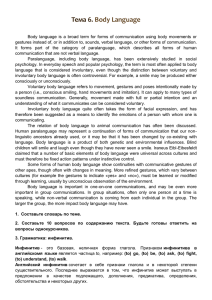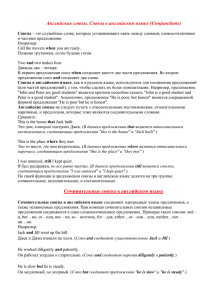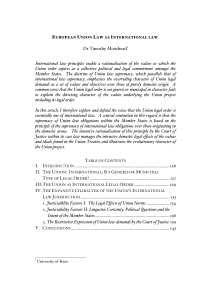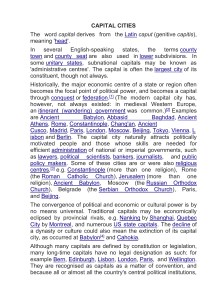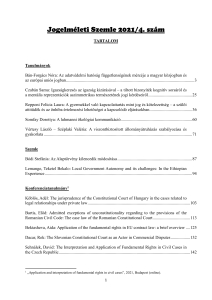3ccc6327-68b1-11e5-9d50
реклама
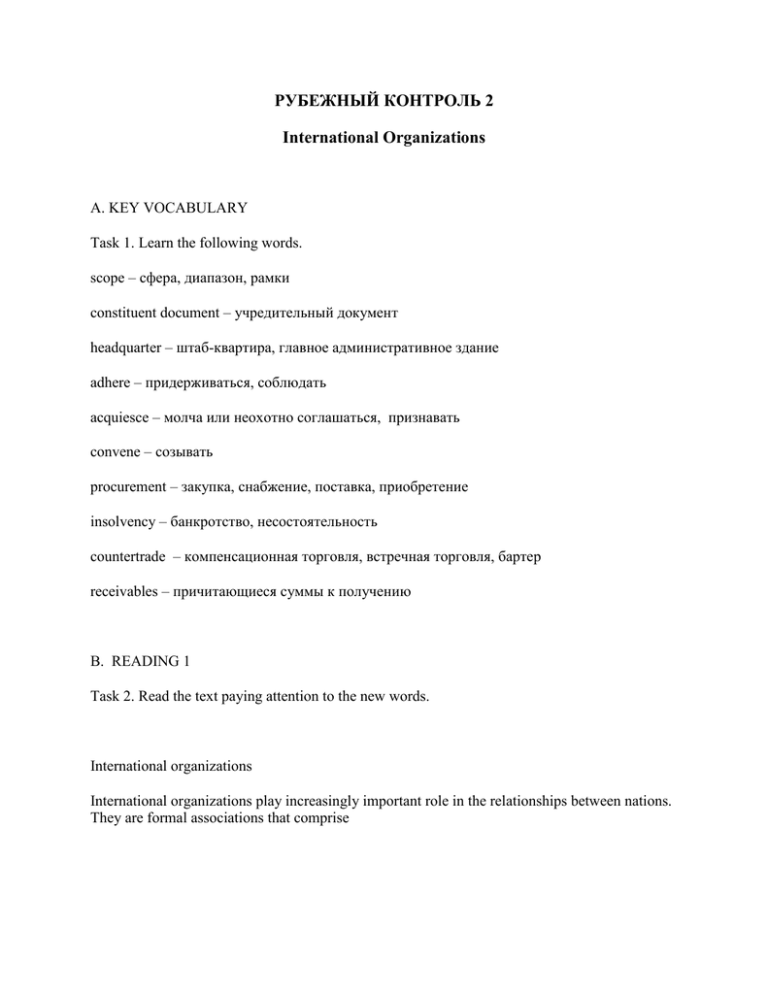
РУБЕЖНЫЙ КОНТРОЛЬ 2 International Organizations A. KEY VOCABULARY Task 1. Learn the following words. scope – сфера, диапазон, рамки constituent document – учредительный документ headquarter – штаб-квартира, главное административное здание adhere – придерживаться, соблюдать acquiesce – молча или неохотно соглашаться, признавать convene – созывать procurement – закупка, снабжение, поставка, приобретение insolvency – банкротство, несостоятельность countertrade – компенсационная торговля, встречная торговля, бартер receivables – причитающиеся суммы к получению B. READING 1 Task 2. Read the text paying attention to the new words. International organizations International organizations play increasingly important role in the relationships between nations. They are formal associations that comprise three or more states. An international organization is one that created by international agreement or which has membership consisting primary of nations. However, in common usage, the term is usually reserved for intergovernmental organizations (IGO) such as the United Nations, the European Union, the Council of Europe, or the World Trade Organization, with sovereign states or other IGOs as members. Their scope and aims are most usually in the public interest but may also have been created with a specific purpose. Legal nature. Legally speaking, an international organization may be established by a constituent document such as a charter, a treaty, or a Convention, which when signed by the founding members, provides the IGO with legal recognition. International organizations are sustained by regular meetings of member states, and supported by a permanent secretariat. They generally have physical headquarters as well as staff who are not only employed by but can also speak for their organization. In 2004, the Union of International Associations recognized some 238 international organizations of this kind. International organizations so established are subjects of international law, capable of entering into agreements among themselves or with states. Thus international organizations in a legal sense are distinguished from mere groupings of states, such as the G-8* and the G-77*, neither of which have been founded by a constituent document and exist only as task groups, though in non-legal contexts these are sometimes referred erroneously as international organizations. Membership. International organizations differ in function, membership and membership criteria. Membership of some organizations (global organizations) is open to all the nations of the world as far as they comply with membership criteria and after approval by a general assembly or similar body. This category includes the United Nations and its specialized agencies and the World Trade Organization. Other organizations are only open to members from a particular region or continent of the world, like European Union, African Union, ASEAN and other regional organizations. Purpose of international organizations. International organizations describe and define their purpose in their charter or other document of creation. International Organizations exist with diverse aims, including but not limited to increase international relations, promote education, health care, economic development, environmental protection, human rights, humanitarian efforts, inter-cultural approach and conflict resolution. ---------------------------------------------------*The Group of Eight (G8), also known as Group of Seven and Russia - is an international forum for the governments of Canada, France, Germany, Italy, Japan, Russia, the United Kingdom, and the United States. Together, these countries represent about 65\% of the Gross World Product and the majority of global military power (7 of the top 8 positions for military expenditure, and almost all of the world's active nuclear weapons). *The Group of 77 at the United Nations is a loose coalition of developing nations, designed to promote its members' collective economic interests and create an enhanced joint negotiating capacity in the United Nations. There were 77 founding members of the organization, but the organization has since expanded to 130 member countries. Task 3. Answer the following questions. 1. What are international organizations? 2. How can an international organization be established? 3. How do international organizations differ from mere groupings of states? 4. Say some words about membership criteria. 5. Why are international organizations created? Task 4 a) Which of these are international organizations? What do these abbreviations stand for? Give the Russian equivalents to them. CIA NATO UN BBC IMF WHO IRS OPEC UK EU ILO US FBI b) Complete the sentences choosing the abbreviations from the task… 1) The was set up in 1945 to keep world peace and help international co-operation. 2) The modern FIFA WTO NASA grew out of the original European Community, also known as the Common Market. 3) The is the department of the US government that collects national taxes. 4) Most countries which export oil belong to . 5) The American works, normally secretly, to collect information about other countries. 6) is the organization that controls international football and organizes the World Cup competition. 7) is a military alliance of the USA, Canada, and most West European countries. 8) study of space. is a US government organization that controls space travel and the scientific 9) The 10) The investigates crime in America. is an international organization that tries to encourage trade between countries and to help poorer countries develop economically. C. PROJECT-WORK Task 5. Using available sources (Internet, encyclopedias, etc) find the information (year of establishment; headquarters location; member states; main goals) about the following international organizations: - African Union - International Hydrographic Organization - International Criminal Police Organization (ICPO) - Arab League - Organization for Security and Cooperation in Europe (OSCE) - La Francophonie - GUAM - UNESCO D. READING 2 Task 6. Read the text and be ready to do the tasks below. The United Nations The United Nations, the most influential among international organizations, was established in 1945 as the successor to the League of Nations. Its headquarters are in New York City. The declared purposes of United Nations are to maintain peace and security, to develop friendly relations among nations, to achieve international cooperation in solving international problems, and to be a center for harmonizing the actions of the nations and attaining their common ends. The Charter of the United Nations has been adhered to by virtually all states. Even the few remaining nonmember states have acquiesced in the principles it established. The International Court of Justice is established by the UN Charter as its principal judicial organ. The United Nations Charter created elaborate machinery for maintaining peace and security and for solving disputes among nations. The principal organs of the United Nations are: - The General Assembly - The Security Council - The Economic and Social Council - The Trusteeship Council - The Secretariat - The International Court of Justice The UN also specifically directed the General Assembly to encourage the progressive development and codification of international law. To carry out this task, the General Assembly created two subsidiary organs: the International Law Commission and the Commission on International Trade Law (UNCITRAL). Over the years the International Law Commission has prepared drafts of treaties codifying and modernizing a number of important topics of international law, including the law of the sea, diplomatic relations, consular relations, law of treaties between nations, succession of states in respect to treaties, law of treaties between nations and international organizations, immunity of states from the jurisdiction of other states, and the law of international freshwaters. The Commission on International Trade Law drafts texts on laws concerning international commerce and economic development. Upon acceptance by the General Assembly, drafts from the commissions usually are submitted to international conferences called by the UN for adoption of the respective conventions. The General Assembly convenes once a year, usually on the third Tuesday in September. Its resolutions and statements are not binding international law. They can however become common law if generally accepted over a long time frame. On the other hand, the resolutions of the UN Security council however are binding law to all member states. In some instances, the UN has organized conferences to discuss major international issues or to negotiate treaties without prior proposal by the International Law Commission. The most important example was the third UN Conference on the Law of the Sea, which terminated its work in 1982. The conference adopted a convention (which came into force in 1994) governing all aspects of the peaceful use of the oceans, including territorial boundaries, navigational rights, and economic jurisdiction. Another example is the 1992 UN Conference on Environment and Development, held in Rio de Janeiro, Brazil, and informally known as the Earth Summit. The conference produced two major treaties: the Convention on Biological Diversity, which seeks to preserve the world’s biological diversity and promote the sustainable use of its components; and the Framework Convention on Climate Change, which seeks to limit industrial emissions of gases leading to global warming. Sometimes the UN convenes major conferences to assess progress and problems concerning a specific topic, without adopting a new agreement. Such conferences have been held on human rights and on the status of women worldwide. A landmark in the development of international law occurred in 1998 at a UN diplomatic conference in Rome, Italy, when 120 countries adopted a treaty to establish the world’s first permanent international criminal court. Officially established in 2002, the International Criminal Court (ICC) operates independently of the United Nations and has the power to initiate investigations and prosecutions of war criminals, including those accused of genocide, crimes against humanity, and other serious crimes. Unlike previous war crimes tribunals, such as those created in response to atrocities in the former Yugoslavia and in Rwanda, the ICC’s jurisdiction is not limited to specific conflicts. Task 7. Look through the text again and complete the following file: The United Nations 1. Year of establishment: 2. Headquarters location: 3. Constituent document: 4. Main purpose: 5. Principal organs: 6. Principal judicial body: 7. Subsidiary organs of the General Assembly: 8. Main goals of International Law Commission: 9. Main goals of UNCITRAL: 10. Examples of major international issues discussed at UN conferences: 11. Main goals of ICC: Task 8. Work in pairs. Using your file put questions to your partner and make him/her answer them. e.g. When was the UN created? E. VOCABULARY Task 9. The UN International Commission on Trade Law (UNCITRAL) is the core legal body of the United Nations system in the field of international trade law. First read through the key areas with which UNCITRAL is involved. Then find the words/phrases in this text with the closest meanings to the definitions below the text. UNCITRAL • Worldwide acceptable conventions, model laws and rules • Legal and legislative guides and recommendations of great practical value • Updated information on case law and enactments of uniform commercial law • Technical assistance in law reform projects • Regional and national seminars on uniform commercial law • Sale of goods, arbitration, electronic commerce, procurement, negotiable instruments, project finance, insolvency, countertrade, construction contracts, guarantees, receivables financing, letters of credit, maritime transport a) bankruptcy: b) law established on the basis of previous verdicts: c) accounts that are due to be paid: d) the movement of goods by sea: e) a letter from a bank, usually for presentation to another branch or bank, authorizing it to issue credit or money to the person named: f) measures with legal force: g) support: h) being the same as another: i) a procedure for the resolution of disputes: j) a system of international trade in which countries exchange goods or services, rather than paying for imports with currency: k) suggestions: l) agreements: m) building agreements: n) process to buy and sell through the Internet: o) the latest of most modern: p) purchase: F. TRANSLATION Task 10. Translate into English. В современный период наиболее известными международными организациями являются Организация Объединенных Наций (ООН), Организация Объединенных наций по вопросам образования, науки и культуры (ЮНЕСКО), Международная организация труда (МОТ), Всемирная Организация Здравоохранения (ВОЗ), Совет Европы, Организация по безопасности и сотрудничеству в Европе (ОБСЕ) и др. Наименования организаций могут быть различными (организация, лига, ассоциация, союз, фонд, банк и т.д.), это не влияет на их статус. Для классификации международных организаций применяют различные критерии. 1) По характеру членства организации делятся на правительственные и неправительственные. 2) По кругу участников организации бывают универсальные (т.е. открыты для участия всех государств, например, ООН, МАГАТЭ), региональные (их членами могут быть государства или объединения определенного географического региона, например, Организация африканского единства), или межрегиональные (например, Организация стран-экспортеров нефти) 3) По компетенции организации бывают общей компетенции(их деятельность затрагивает все сферы отношений – политическую, экономическую, культурную) и специальной компетенции (сотрудничество ограничивается одной специальной областью, например, ВОЗ, МОТ) 4) С точки зрения порядка приема международные организации делятся на открытые (любое государство может стать членом данной организации) и закрытые (прием в члены производится по приглашению первоначальных учредителей, например, НАТО).
